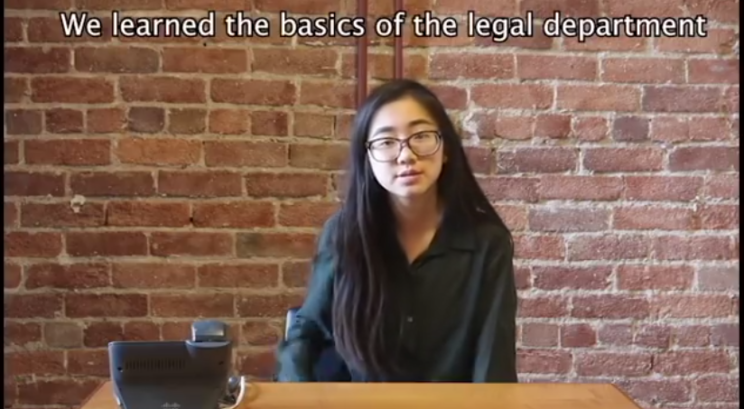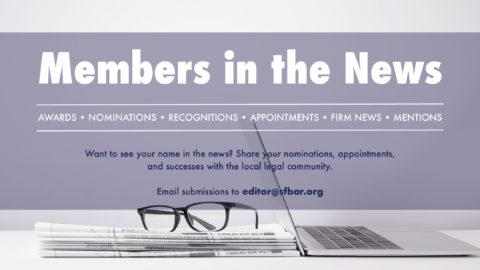Kitty Zeng is a high school student at Balboa High School in San Francisco, where she takes part in Law Academy. Established in 1997 by then Bar Association of San Francisco (BASF) President Judge Jeffrey Ross, San Francisco Law Academy is a program that encourages, inspires, and increases career opportunities for students. Creative and inspiring curriculum is built into several core classes where juniors and seniors learn basic legal concepts and interview and job skills. A summer fellowship gives rising juniors direct work experience and school credit as paid fellows in law firms and legal departments.
Kitty spent six weeks this summer as a fellow at the bar association, where she spent time with different departments at BASF and the Justice & Diversity Center (JDC). Over the next two months, we will share excerpts of Kitty’s reflections and observations here on our blog:
Reflections Week 1
Coming into a new environment is very nerve-wracking but luckily, the people here are all really nice and willing to help me out. The first thing that I learned is that there are two organizations: The Bar Association of San Francisco and the Justice & Diversity Center.
I learned that there are many departments needed to keep the organization running smoothly. It’s astonishing because I used to believe they only needed a few people to run the organization.
A meeting that I really enjoyed was with Wint [Wint Huskey, Paralegal for JDC’s Community Organization Representation Project] about nonprofit law and contract law. I learned that multiple people are required to run nonprofit organizations whereas one person can single-handedly run a for-profit organization. Since both nonprofits and for-profits are treated equally in terms of contracts and damages, it holds the nonprofits accountable for all the grants and donations they receive.
Reflections Week 2
This week, I had another informational interview, this time with Carole [Conn], the director of the Lawyer Referral & Information Service and Alternative Dispute Resolution departments. I learned about litigation and the alternatives to it: mediation and arbitration. Since I have a few friends in the military, I was interested in the Military Assistance Program (MAP). MAP provides legal assistance to military persons and veterans at a discounted rate.
During my visit at the Homeless Advocacy Project (HAP) clinic, I obtained insight onto what it is like to work directly with the community. It was extremely eye-opening and heart-breaking to hear about mistreatments and current housing conditions.
One thing that I noticed during the intakes was that the staff has to be very empathetic. The line that stood out to me was when Erin [Erin Katayama, supervising attorney at HAP] said that they don’t pick and choose which cases they represent because “everyone should have access to the justice system.” After the visit, I finally understood why organizations like HAP are vital for the diversity, culture, and people of the community.
Reflections Week 3
I started out the week by sitting in on intake calls with the Legal Referral & Information Service (LRIS) department. Even though I was aware that they take approximately 60,000 calls a year, I didn’t realize that they accepted calls back to back on a daily basis. While listening in on the calls, I noticed that the staff must be careful about not agitating the caller by making them more emotional than they already are. There is a whole spectrum on what calls they receive. Something that Antonio [Antonio Hernandez, LRIS Supervisor], said to me really stood out. He said, “It’s not what you say, it’s how you say it.” I think it fits perfectly for this department because they’re always talking to someone new and people are inclined to believe that they’re always correct. Additionally, the callers are extremely emotional while calling, which makes communicating a delicate process.
To prepare for the “Getting and Keeping Attention. Jobs, Judges and Juries” presentation, I did some research on the topic. I learned that the judge’s role isn’t necessarily the same in every type of trial. I always thought that the judge makes the final decision but that isn’t the case in a jury trial.
At the presentation, I learned that as the speaker, you can only retain the audience’s attention for a limited time. The rule of 3 is to help keep the audience’s attention throughout the whole time you’re talking. By stating the 3 main points, in the beginning, the audience will continuously look out for those points during the duration of the speech.
I found the presentation on Tuesday helpful because from this point on, I’ll only engage in public speaking even more. Knowing how to keep the audience’s attention is vital because the main point is to get your information to the audience. It wouldn’t matter how well you speak in public if the audience doesn’t listen to it.
Hear more from Kitty at the JDC Annual Gala on September 27, where she will address guests to share her Law Academy experience.
Kitty is a Law Academy Fellow who spent six weeks working at BASF this summer. She is a sophomore in high school who is interested in pursuing either law or medicine at one of her “dream” schools, UCLA or UC Davis.



